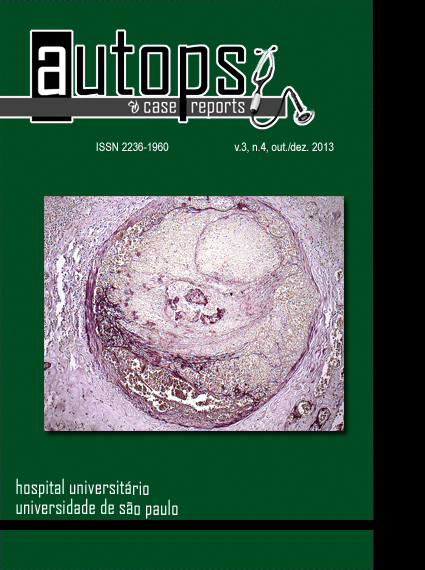Unusual tomographic findings of complicated necrotizing pancreatitis
Keywords:
Pancreatitis, Acute Necrotizing, Hemoperitoneum, Duodenal Diseases.Abstract
Acute pancreatitis (AP) is a potential life-threatening disease, which originates from inflammatory involvement of the pancreas and surrounding tissues. Serious complications eventuate and treatment is difficult. AP is classified in both interstitial edematous pancreatitis, which occurs in 70-80% of patients, and necrotizing pancreatitis, which occurs in 20-30% of patients. Diagnosis is based on the presence of two of the following criteria: abdominal pain, increased serum determination of amylase and/or lipase more than three times the reference value, and characteristic tomographic findings. Among the latter, there is the pancreatic and surrounding tissue damage as well as that related to distant organ involvement. This case report shows the fatal case of a male patient with a history of heavy alcoholic abuse admitted with the diagnosis of necrotizing pancreatitis. The authors call attention to the unusual tomographic findings; namely, a huge duodenal hematoma and a large hemoperitoneum, ischemic involvement of the spleen and kidneys, as well as pancreatic and peripancreatic necrosis.Downloads
Download data is not yet available.
Downloads
Published
2013-12-17
Issue
Section
Article / Clinical Case Report
License
Copyright
Authors of articles published by Autopsy and Case Report retain the copyright of their work without restrictions, licensing it under the Creative Commons Attribution License - CC-BY, which allows articles to be re-used and re-distributed without restriction, as long as the original work is correctly cited.
How to Cite
Sigrist, R. M. S., Gomes, S. I. M., Possagnolo, D. T., & Martines, B. M. R. (2013). Unusual tomographic findings of complicated necrotizing pancreatitis. Autopsy and Case Reports, 3(4), 63-68. https://revistas.usp.br/autopsy/article/view/75878



